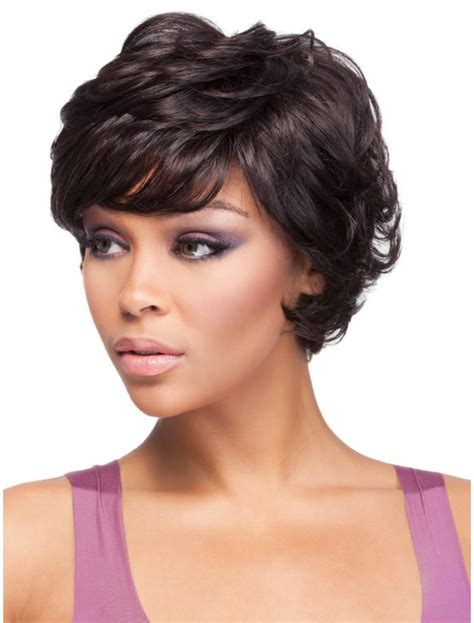Understanding Short Wigs for Women
Short wigs have become increasingly popular among women of all ages. With countless styles, colors, and textures available, they offer a versatile solution for enhancing your appearance and boosting your confidence.

According to recent industry reports, the global short wig market is projected to reach a staggering $15 billion by 2025. This growth is attributed to factors such as rising hair loss concerns, fashion trends, and the convenience of short hairstyles.
Types of Women’s Short Wigs
The wide range of women’s short wigs can be categorized into several types:
Lace Wigs:
* Thin, lace-based wigs that mimic the natural hairline
* Provide a realistic and undetectable appearance
* Available in various lace types (e.g., Swiss lace, French lace)
Closure Wigs:
* Wigs with a smaller lace closure on the top of the head
* Allow for versatile styling, such as ponytails and buns
* More affordable than full lace wigs
Frontal Wigs:
* Similar to lace wigs, but with a wider lace area across the forehead
* Create a natural-looking hairline and scalp
* Offer more styling options than closure wigs
Human Hair Wigs:
* Made from 100% human hair
* Natural-looking, soft, and durable
* Can be styled with heat tools
* More expensive than synthetic wigs
Synthetic Hair Wigs:
* Made from synthetic fibers
* Available in a wide range of colors and textures
* Less expensive and require less maintenance than human hair wigs
* Can be more prone to tangling and heat damage
Choosing the Right Short Wig
Selecting the perfect short wig depends on your personal preferences and needs. Consider the following factors:
Face Shape:
* Oval faces suit most wig styles
* Round faces should opt for asymmetrical or off-center wigs
* Square faces look good with wigs that add volume on the top
* Long faces benefit from wigs with blunt cuts and bangs
Hair Texture:
* Match the texture of your own hair for a natural transition
* Consider wavy or curly wigs if you have thick hair
* Opt for straight or sleek wigs if you have fine hair
Hair Length:
* Short wigs come in various lengths, from pixie cuts to bob haircuts
* Shorter wigs are low-maintenance and easy to style
* Longer wigs offer more versatility and styling options
Common Mistakes to Avoid
When choosing and wearing a short wig, avoid these common pitfalls:
- Wearing the Wrong Size: A wig that is too small or too large will be uncomfortable and unnatural-looking.
- Incorrect Application: Improper wig application can create an unnatural appearance. Follow instructions carefully and consult a professional if needed.
- Over-Styling: Excessive styling with heat tools can damage synthetic wigs. Limit heat usage and use protective products.
- Neglecting Maintenance: Wigs require regular care to maintain their appearance. Brush gently, wash, and condition as needed.
- Storing Improperly: Store wigs on a wig stand or in a breathable bag to prevent tangling and damage.
Step-by-Step Guide to Wig Application
- Prepare Your Hair: Protect your natural hair by braiding or pinning it down.
- Place the Wig: Gently place the wig on your head and position it correctly.
- Secure the Wig: Use wig clips or adhesive to secure the wig and prevent it from slipping.
- Style the Wig: Style the wig to suit your desired look. Use hairspray or styling products as needed.
Pros and Cons of Short Wigs for Women
Pros:
* Instant hair transformation
* Versatility and styling options
* Reduced hair loss concerns
* Confidence boost
Cons:
* Requires maintenance and care
* Can be expensive
* Synthetic wigs may not be as natural-looking as human hair wigs
Creative Applications for Short Wigs
In addition to enhancing your appearance, short wigs can also serve creative purposes:
- Cosplay: Transform into your favorite characters with realistic and stylish wigs.
- Theater and Film: Create unforgettable characters by using wigs to alter hair color and style.
- Fashion Design: Experiment with different wig styles and textures to complement clothing designs.
- Educational Demonstrations: Use wigs to illustrate hair styling techniques and hair care practices.
Helpful Tables
Table 1: Types of Short Wigs
| Type | Construction | Appearance |
|—|—|—|
| Lace Wig | Thin, lace-based | Natural and undetectable |
| Closure Wig | Lace closure on top | Versatile styling options |
| Frontal Wig | Wide lace area across forehead | Natural hairline and scalp |
| Human Hair Wig | 100% human hair | Natural-looking, soft, and durable |
| Synthetic Hair Wig | Synthetic fibers | Wide range of colors and textures |
Table 2: Face Shapes and Wig Styles
| Face Shape | Suitable Wig Styles |
|—|—|
| Oval | Most wig styles |
| Round | Asymmetrical or off-center wigs |
| Square | Wigs that add volume on top |
| Long | Wigs with blunt cuts and bangs |
Table 3: Wig Maintenance Tips
| Maintenance Task | Frequency |
|—|—|
| Brushing | Daily |
| Washing | As needed (1-2 times per week) |
| Conditioning | Every 2-3 washes |
| Detangling | When necessary |
Table 4: Troubleshooting Common Wig Problems
| Problem | Possible Cause | Solution |
|—|—|—|
| Wig slips | Incorrect size or insufficient securing | Adjust wig size or secure more tightly |
| Unnatural appearance | Improper application or wrong wig style | Reposition wig or choose a wig that suits your face shape |
| Tangling | Excessive heat styling or neglect | Use heat protectant and detangle gently |
| Damage | Improper storage or over-styling | Store wig properly and limit heat usage |
